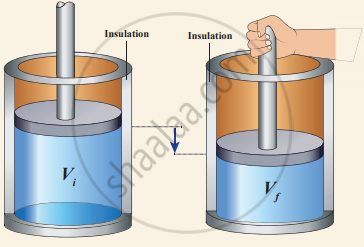Advertisements
Advertisements
प्रश्न
Derive the work done in an adiabatic process.
उत्तर
Work done in an adiabatic process: Consider µ moles of an ideal gas enclosed in a cylinder having perfectly non-conducting walls and base. A frictionless and insulating piston of cross-sectional area A is fitted in the cylinder.
Let W be the work done when the system goes from the initial state (Pi, Vi, Ti) to the final state (Pf, Vf, Tf) adiabatically.

Work done in an adiabatic process
W = `int_("V"_"i")^("V"_"f") "PdV"` ..........(1)
By assuming that the adiabatic process occurs quasi-statically, at every stage the ideal gas law is valid. Under this condition, the adiabatic equation of state is PVγ = constant (or)
P = `"constant"/"V"^γ` can be substituted in the equation (1), we get
∴ Wadia = `int_("V"_"i")^("V"_"f") "constant"/"V"^γ "dV" = "constant" int_("V"_"i")^("V"_"f") "V"^-γ "dV"`
= `"constant" [("V"^(-γ + 1))/(-γ + 1)]_("V"_"i")^("V"_"f") = "constant"/(1 - γ) [1/("V"_"f"^(γ - 1)) - 1/("V"_"i"^(γ - 1))]`
= `1/(1 - γ) ["constant"/("V"_"f"^(γ - 1)) - "constant"/("V"_"i"^(γ - 1))]`
But, `"P"_"i""V"_"i"^γ = "P"_"f""V"_"f"^γ = "constant"`
∴ Wadia = `1/(1 - γ) [("P"_"f""V"_"f"^γ)/("V"_"f"^(γ - 1)) - ("P"_"i""V"_"i"^γ)/("V"_"i"^(γ - 1))]`
Wadia = `1/(1 - γ) ["P"_"f""V"_"f" - "P"_"i""V"_"i"]` .......(2)
From ideal gas law, PfVf = μRTf and PiVi = μRTi
Substituting in equation (2), we get
∴ Wadia = `(μ"R")/(γ - 1) ["T"_"i" - "T"_"f"]` ..........(3)
In adiabatic expansion, work is done by the gas. i.e., Wadia is positive. As Ti > Tf the gas cools during adiabatic expansion.
In adiabatic compression, work is done on the gas. i.e., Wadia is negative. As Ti < Tf the temperature of the gas increases during adiabatic compression.


PV diagram - Work done in the adiabatic process
To differentiate between isothermal and adiabatic curves in the PV diagram, the adiabatic curve is drawn along with the isothermal curve for Tf and Ti. Note that the adiabatic curve is steeper than an isothermal curve. This is because γ > 1 always.
APPEARS IN
संबंधित प्रश्न
Explain why The climate of a harbour town is more temperate than that of a town in a desert at the same latitude.
Draw a p-V diagram showing positive work with varying pressure.
Draw a p-V diagram showing negative work with varying pressure.
Draw the PV diagram for the adiabatic process.
Draw the PV diagram for the isochoric process.
Explain in detail the isothermal process.
What are the limitations of the first law of thermodynamics?
For a given ideal gas 6 × 105 J heat energy is supplied and the volume of gas is increased from 4 m3 to 6 m3 at atmospheric pressure. Calculate
- the work done by the gas
- change in internal energy of the gas
- graph this process in PV and TV diagram
In which of the following processes, beat is neither absorbed nor released by a system?
An ideal gas A and a real gas B have their volumes increased from V to 2V under isothermal conditions. The increase in internal energy ____________.
